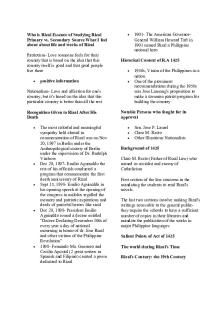Life and Works of Rizal (LWR) Reviewer PDF

| Title | Life and Works of Rizal (LWR) Reviewer |
|---|---|
| Author | Nina Uy |
| Course | Bachelor of Public Administration |
| Institution | Pamantasan ng Lungsod ng Maynila |
| Pages | 17 |
| File Size | 459.3 KB |
| File Type | |
| Total Downloads | 159 |
| Total Views | 394 |
Summary
Who is Rizal Essence of Studying RizalPrimary vs. Secondary Source What I feelabout about life and works of RizalPatriotism- Love someone feels for theircountry that is based on the idea that thiscountry itself is good and that good peoplelive there• positive informationNationalism- Love and affecti...
Description
Who is Rizal Essence of Studying Rizal Primary vs. Secondary Source What I feel about about life and works of Rizal Patriotism- Love someone feels for their country that is based on the idea that this country itself is good and that good people live there •
positive information
•
Historical Context of R.A 1425 • •
Nationalism- Love and affection for one's country, but it's based on the idea that this particular country is better than all the rest Recognition Given to Rizal After His Death •
•
•
•
•
The most colorful and meaningful sympathy held abroad in commemoration of Rizal was on Nov 20, 1897 in Berlin under the Anthropological society of Berlin under the supervision of Dr. Rudolph Virchow Dec 29, 1897- Emilio Aguinaldo the rest of his officials conducted a program that commemorate the first death anniversary of Rizal Sept 15, 1898- Emilio Aguinaldo in his opening speech at the opening of the congress in malolos regalled the memory and patriotic aspirations and deeds of peaceful heroes like rizal Dec 20, 1898- President Emilio Aguinaldo issued a decree entitled "Decree Declaring December 30th of every year a day of national mourning in honor of dr. Jose Rizal and other victims of the Philippine Revolution" 1898- Fernando Ma. Guerrero and Cecilio Apostol (2 great writers in Spanish and Filipino) created a poem dedicated to Rizal
1901- The American GovernorGeneral William Howard Taft in 1901 named Rizal a Philippine national hero
1950s, Vision of the Philippines as a nation One of the prominent recommendations during the 1950s was Jose Lansang's proposition to make a common patriot program for building the country
Notable Persons who fought for its approval • • •
Sen. Jose P. Laurel Claro M. Recto Other Illustrious Nationalists
Background of 1425 Claro M. Recto (Father of Rizal Law) who named as socialist and enemy of Catholicism First section of the law concerns in the mandating the students to read Rizal's novels. The last two sections involve making Rizal's writings accessible to the general publicthey require the schools to have a sufficient number of copies in their libraries and mandate the publication of the works in major Philippine languages Salient Points of Act of 1425 The world during Rizal's Time Rizal's Century: the 19th Century
• •
•
•
Jose Rizal was born in the 19th century (June 19, 1861) During this time, Spain's glory and rule as a colonial power was already waning The natives at the Philippines were slowly realizing the need to awaken their national consciousness This was sparked by movements against the oppression of the Spanish Colonizers
•
•
• •
Who is the person who used the Filipino? •
• •
•
•
It was Jose Rizal who first used the word Filipino to refer the inhabitants of the country, whether they are Spanish or Filipino blood Indios- Native inhabitants Filipinos- Inhabitants with Spanish blood (peninsulares, insulares, mestizo) He realized that people residing in the Philippines should be could name- Filipino When ordered to sign the notification of his death sentence, which described him as a Chinese mestizo, Rizal refused. He went to his death saying that he was indio puro (S. Delmendo, 2005)
What happened to the economic status of Philippines during 19th Century? • • •
•
Positive Impact because of Free trade Economic system, mercantilism to free trade The rise of the export economy because of the demand increase of other countries to our products Filipino merchants and small-scale industrialists become prominent in Philippine Society, thus forming a new group of influential middle-class Filippinos
The rise of commercial agriculture gave birth to a new social class. Along with the church's landholdings and the pre-Spanish nobility's rice states. Some of the families who rose to prominence in the 19th century have remained influential in Philippine politics and economics Public education did not begin until 1863 Prominent figures in Propaganda movement, against the colonizers came from the middles class
Important Contribution of Suez Canal •
• • •
•
direct commercial relations with Spain instead of through Mexico (via the galloon trade) 17 November 1869 Migration two types of teachers Jesuits and Friars Friars- did not do too much to educate Filipinos since they were suspicious about the success of the Filipinos invariably. Jesuits- were responsible for the awakened minds of Filipinos. Inculcated among Filipino students a sense of nationalism through their humanistic form of education
What is the cultural trace of Spanish in the Philippines? • • •
Roman Catholic Food Attitude
How Friars paved the way in creating an influence in the country’s political system? •
no separation of government and churches
• •
•
•
•
they don't to lose the country of Philippines Spanish friars, are in crucial position in maintaining in the Philippine Archipelago as a Spanish Colony Filipinos turned more and more to the friars for moral and political guidance as Spanish civil officials in the country become more corrupt and immoral The Friars then became more influential and powerful because of fraiocracy or the rule of friars (Lopez Jaena used the term trailorocacy) the growing power of the friars in the 19th century urged the reformists and nationalists to work harder to let the people know who the real enemies were
Racial Heirarchy of Colonial Philippines
Union of Church and State •
• •
• •
•
Spanish friar- supervising representative of the Spanish Government for all local affairs He was practically the ruler of town as he was the local inspector His approval was required in census lists, tax lists, list of army conscripts and register births, deaths and marriages. Frailocracia- fear of the civil authorities to the friars Guardia Civil- organized in 1867, a corps of native police under the leadership of Spanish officer for the purpose of dealing with outlaws and renegades In 1880. it was the most feared instrument of summary arrests of individuals
What is the Political image and social status of Philippines?
Aside from the unjust treatment of Spaniards among Filipino's what are the other inspiration behind their cry out loud for political reform? The French and American revolutions impact •
Filipino inspire to the rise in political consciousness among these countries, that resulted to their desire for legislative change. The governing class first took a repressive approach against any change as a result of the French Revolution and its bloodshed, but as the 19th century proceeded,
the rising reform movement became increasingly impossible to ignore.
•
Summary of Long-Term Causes • •
•
• •
•
Population growth and declining standard of living increased pressures on an inefficient economy Writings of the philosophes inspired criticism of the Royal Government and powerful church Extravagances of the Court exhausted the treasury Efforts of the king's ministers to reduce privileges, reform taxes, cut spending, and introduce free trade within France had all failed The Royal Government
What is the condition of Europe, America and Asia during 19th Century? •
•
The Great Game that describes the power competition between Russia and Great Britain in the 19th century over the future of Central Asia Russian expansion and the moves made by Britain to counter what they thought was Russian aggression in the region
Causes of the Civil War • • • •
Economy States' Rights vs. Federal Rights Slavery Election of Abraham Lincoln
What happened to Africa and Latin America during 19th Century? • •
Leaving on their own slavery, stealing the people
The changing Religious Front in the Philippines: Secularization
•
Governador Ando's arrival in 1770, Anda's administration gave hope for the success of Philippine secularization The abolition of privileges enjoyed by the arsenals and the force labor work for Filipino natives in Cavite made a significance on the rise of the Revolution GOMBURZA as example of revolution
Rizal’s Family Background and Historical Background Dr. Jose P. Rizal •
He was born June 19, 1861
•
He is a patriot
•
Has been an inspiration for the Filipinos
•
National Hero
Jose Rizal’s Family •
Wealthy family in Calamba, Laguna
•
One of the largest families in the Spanish era
They had also traced of Japanese, Spanish, Malay and Even Negrito blood aside from Chinese. Ancestry •
Domingo Lam-co, Family’s paternal ascendant he is a full-blooded chinese.
•
He married Chinese half breed Ines De la Rosa
•
Francisco Mercado Married Bernarda Monicha
•
Juan Mercado married Cirila Alejandra
•
The surname Rizal was obtained by Francisco Mercado as suggested to him by the governor Narciso Claveria.
•
They don’t actually use the Rizal surname. Their family wants to use the surname they really have instead of using Rizal.
Rizal’s Childhood Experiences Calamba, Laguna - Rizal’s Hometown June 19, 1861- birth
Francisco Mercado •
He is Jose Rizal’s father
•
Rizal’s Father was the youngest of 13 children of Juan and Cirila Mercado.
•
Described by Rizal as Model of Fathers
•
Born in Binan, Laguna. Studied Latin and philosophy in San Jose College of Manila.
Teodora Alonso Realonda •
He is the mother of Jose Rizal
•
Was born in Santa Cruz, Manila on November 14, 1827
•
Business minded, religious and hardworking individual
•
Second child of Brigida de Quintos and Lorenzo Alonso
•
Studied at the Colegio de Santa Rosa
Rizal Family •
Rizal’s parents were farmers who were granted by the Dominicans with the lease of a hacienta together with a rice farm.
June 19, 1861 - The seventh child of Francisco Mercado Rizal and Teodora Alfonso Y Quintos was born in Calamba, Laguna. June 22, 1861 - He was baptized Jose Rizal Mercado at the Catholic of Calamba by parish priest Rufino Collantes with Rev. Pedro Casanas as the sponsor. September 28, 1862 - The parochial church of Calamba and the canonical books, including the book in which Rizal’s baptismal records were entered, were burned. Rizal’s Family Garden – The first memory of Rizal, in his infancy was his happy days in garden when he was 3 years old. Angelus Prayer - By nightfall, Rizal’s Mother gathered all the children at the house to pray Angelus. o
Loved to go to church to take part in novenas, and join religious processions.
o
Called Manong Jose by Hermanos and Hermanas Terceras.
o
Father Leanciano Lopez (Town Priest)
o
Rizal Used to visit and listen to his stimulating opinions on current event and sound philosophy of life.
o
1864 - Barely three years old, Rizal learned the alphabet from his mother.
o
1865 - When was four years old, his sister Conception, the eight children in the Rizal family, died at the age of three. It was on this occasion that Rizal remembered having shed real tears for the first time.
Artistic Talent At the age of five, he began to make sketches with his pencil and to mold on clay and wax objects. 1865-1867 - During this time his mother taught him how to read and write. His father hired a classmate by the name Leon Monroy who, for five months until (monoy) death, taught Rizal the rudiments of Latin.
December 17, 1870 - Having finished his studies in Binan, Rizal returned to Calamba on board the motorboat talim. His parents planned to transfer him to Manila where he could continue his studies.
Ang Gamugamo at Ang Liwanag May lilipad-lipad na isang gamugamo Sa tapat ng ilaw ng lamparang ito Tuwang-tuwa siya sa liwanag nito Paikot-ikot pa ang munting gamugamo Sabi ng nanay niya, “O anak, halika” Ikaw ay lumayo sa malaking lampara
Uncle Manuel Alberto - taught the latter love for nature
Baka mamaya lang ika’y mahagip pa
Usman - Rizal’s dog
Ng silab ng apoy na maganda pa sa mata
Uncle Gregorio - instilled love for education
“Ay hindi po Inay, ako’y mag-iingat
Pilgrimage to Antipolo - On June 6, 1868, Jose and his father left Calamba to go a Pilgrimage to Antipolo.
Titingin-tingin lang at lilipad-lipad
-
It was the first trip of Jose across Laguna de Bay. After praying at the Shrine of Virgin of Antipolo they went to Manila.
First Poem of Rizal - At the age of eight, he wrote his poem in the native language entitled “Sa Aking Mga Kababata” 1870 - His brother Paciano brought Rizal to Binan, Laguna. He was placed under the tutelage of Justianiano Aquino Cruz, studying Latin and Spanish, in this town he also learned art of painting under the tutorship of a painter by the name of Juancho Carrera. First Drama of Rizal - At the age of eight, Rizal wrote his dramatic work which was in Tagalog comedy.
Hindi po lalapit, ‘di po isasayad Ang maliit ko’t magandang pakpak Walang anu-ano’y narinig ang sigaw Nitong gamugamong dating sumasayaw Lugmok ang katawan, pakpak ay natunaw Nasunog na pala sa lamparang tanglaw Umiyak si Ina at naghinagpis “O anak, bakit nga ba ikaw ay makulit? Matigas ang ulo’t ‘di mapilit-pilit Sa gawang ‘di dapat siya mo namang nais Maging aral nawa’t maging halimbawa Ang nangyayaring itong matinding sakuna Mabait, sumunod sa mga babala
Ng iyong magulang, na nag-aaruga
Summary It was Rizal’s mother who told him about the story of the moth. The Mother moth told her son not to go near the light because it would kill him easily. Rizal’s mother told him that if the son moth only listened to what his Mother said, then her wouldn’t be killed by that fire The Moral of the Story Rizal and the Lessons his Mother Taught Him Teodora Alonso, Rizal's mother, was the person who had the most influence on his development as a person. His mother was his first teacher, and it was from her that he learned to read and, as a result, came to value reading as a means of learning and meaningfully spending one's time. It didn't take long for him to realize the value of time as life's most valuable gift, because she taught him never to waste a single second of it. As a result, as a student in Spain, he became the most conscientious of students, never missing a class despite his activities as a Propaganda leader, or an exam despite having to take it on an empty stomach. He learned the importance of self-improvement from his mother, so as he grew older, he worked hard to understand the logic of mathematics, to write poems, to draw and sculpt, and to paint. Unfortunately, for all of this, he earned not only glory, but also the dread of myopic souls. Apart from running a household, Teodora instilled in him the value of working with one's hands, self-reliance, and entrepreneurship by taking the lead in running the family's
businesses. And by sharing with others, she taught him generosity and how to help make the world a better place for those who had less materially. All of these lessons he put into practice during his exile in Dapitan, where he improved the community by building a dam, encouraging locals to grow fruit trees, establishing a school, and even documenting the local flora and fauna His mother also taught him to value hardearned money and, more importantly, the value of thrift and denying oneself in order to save a portion of one's earnings as insurance against the vagaries of life. Despite growing up in comfort and wealth, he learned to scrimp and save. These would later come in handy for him during his stay in Europe, as he struggled with poverty due to the meager and frequently delayed allowance that his family sent him (by then his family was undergoing financial reverses due to land troubles). Whenever his meager allowance ran out, he skipped lunch and supper, putting on a show for everyone by leaving his dormitory every day to give the impression that he ate his meals outside. However, as he walked through the streets of Berlin or Barcelona, his nostrils would be assaulted by the delicious aroma of the dishes being prepared within buildings and houses, exacerbating his hunger and suffering. Above all, he learned about obedience from her, as in the story of the moth who was burned by the flame because he disobeyed his mother moth's warning not to get too close to the flame. But, as is often the case, life has a funny way of turning around, because obedience to the Catholic Church, as his mother taught him, proved too difficult to live by, especially when he struggled with a crisis of faith in its teachings. Teodora did not take his defection from the Church lightly, seeing it as an apostasy from faith itself.
The unjust arrest of his mother on the charge of conspiring to poison a relative, despite the lack of evidence against her, was a watershed moment in his life that had a profound impact on his later decision to become a political activist. But what made her arrest even worse was the humiliating treatment she received from authorities, who forced her to walk 50 kilometers from Calamba to the provincial jail in Santa Cruz. She was imprisoned there for two years before being released. All of this she accepted with calm and quiet dignity, which Rizal would remember and replicate during his final moments just before a firing squad snuffed out his meaningful life on that fateful December morn in 1896, despite the fact that he was only eleven years old and about to start secondary school in Manila. Rizal’s Achievement as a student in Ateneo
•
member of the Academy of Natural Sciences
•
poetry, literary writing
•
painting - Agustin Saez
•
sculpture - Romualdo de Jesus
•
gymnastics, fencing
University of Santo Tomas •
Rizal entered in 1877
•
Took up for Philosophy and Letters during his freshman year
•
Completed units in Cosmology and Metaphysics, Theodicy, History of Philosophy with marks of Excellent
•
Shifted to Medicine after completing his first year
•
Granted the privilege of taking simultaneously the preparatory course and the first year of medicine
•
Received his four-year practical training in medicine at the Hospital de San Juan de Dios in Intramuros
•
Rizal had obtained the global grade of Notable in all of his subjects
•
Ranked second, in a decimated class of seven who passed the medicine course
In Ateneo •
Rizal entered in 1872
•
Became the emperor of the class
•
During his 4th year in Ateneo, he received 5 medals and graduated as sobresaliente
•
Graduated on March 23, 1877
•
Received the degree of Bachelor of Arts, with highest honors
Similar Free PDFs

Life and Works of Rizal
- 57 Pages

Life and Works of Rizal
- 16 Pages

Life and works of rizal
- 3 Pages
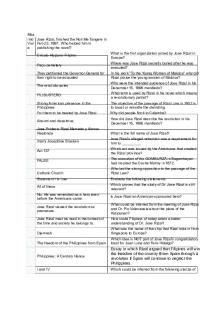
Life works of rizal
- 12 Pages

Rizal life and works
- 15 Pages
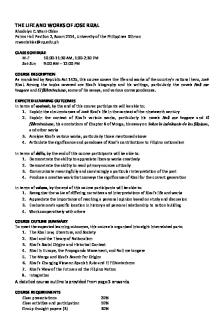
Syllabus Rizal Life and Works
- 13 Pages
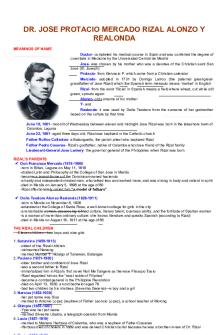
Jose Rizal Life and Works
- 35 Pages

LWRN01G Life-and-Works-of-Rizal
- 156 Pages
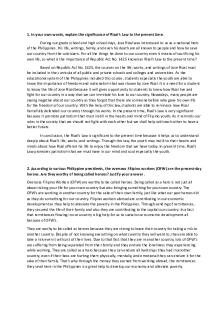
Life and works of Jose Rizal
- 2 Pages

MODULE 7 LIFE AND WORKS OF RIZAL
- 9 Pages

Module in LIFE AND Works OF Rizal
- 97 Pages

LIFE-AND- Works-OF- Rizal- Summary
- 73 Pages

Siblings of Jose Rizal LWR
- 8 Pages
Popular Institutions
- Tinajero National High School - Annex
- Politeknik Caltex Riau
- Yokohama City University
- SGT University
- University of Al-Qadisiyah
- Divine Word College of Vigan
- Techniek College Rotterdam
- Universidade de Santiago
- Universiti Teknologi MARA Cawangan Johor Kampus Pasir Gudang
- Poltekkes Kemenkes Yogyakarta
- Baguio City National High School
- Colegio san marcos
- preparatoria uno
- Centro de Bachillerato Tecnológico Industrial y de Servicios No. 107
- Dalian Maritime University
- Quang Trung Secondary School
- Colegio Tecnológico en Informática
- Corporación Regional de Educación Superior
- Grupo CEDVA
- Dar Al Uloom University
- Centro de Estudios Preuniversitarios de la Universidad Nacional de Ingeniería
- 上智大学
- Aakash International School, Nuna Majara
- San Felipe Neri Catholic School
- Kang Chiao International School - New Taipei City
- Misamis Occidental National High School
- Institución Educativa Escuela Normal Juan Ladrilleros
- Kolehiyo ng Pantukan
- Batanes State College
- Instituto Continental
- Sekolah Menengah Kejuruan Kesehatan Kaltara (Tarakan)
- Colegio de La Inmaculada Concepcion - Cebu
